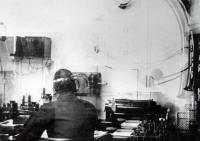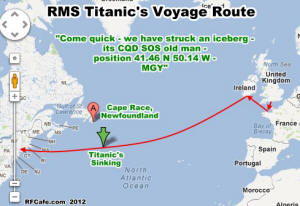Titanic Radio, Compliments of Marconi Wireless Telegraph Company |
|
1 | 2 | 3 | 4 | 5 | 6 | 7 | 8 | 9 | 10 | 11 | 12 | 13 | 14 | 15 | 16 | 17 | 18 | 19 | 20 | 21 | 22 | 23 | 24 | 25 | 26 | 27 | 28 | 29 | 30 | 31 | 32 | 33 | 34 | 35 | 36 | 37 In 2012, we were inundated with stories on the 100-year anniversary of the "unsinkable" RMS Titanic, on April 15, 1912. Even after a century of research and exploration, no definitive cause has been determined relating to how the ship's crew managed to hit a gigantic iceberg on a star-lit, glass-smooth sea. The prevailing theory seems to be that an optical illusion due to an atmospheric inversion caused the crew to misjudge the position of the iceberg. An article in the March 2012 Smithsonian/em> magazine lays out the scenario, complete with diagrams. The same edition has a story titled, "They Missed the Boat," discussing some of the famous people who were originally scheduled to make the voyage, but decided not to before it departed. Amongst the notables was none other than 1909 Nobel Prize in Physics honoree Guglielmo Marconi. Instead, he left for America on the Lusitania three days earlier. Interestingly, he also made the Atlantic passage on the Lusitania three years later on the trip immediately before a German U-Boat sunk it. Talk about a charmed life! The only known photograph of Titanic's radio room. (ARRL QST) Typical Marconi marine 5-kW wireless transmitting set, of the type installed on the Titanic. (IEEE Spectrum) Marconi played a critical role in the Titanic drama without actually being aboard, since his company, Marconi Wireless Telegraph Company, Ltd, owned the radio equipment aboard the Titanic and also employed the two radio operators. The April 2012 edition of the ARRL's QST magazine has a couple articles that focus on the operators of both the Titanic and the Carpathia (the rescuing ship).
The novelty of wireless communication assured the Marconi Wireless Telegraph Company a steady flow of revenue as passengers, many very wealthy, were anxious to have the privilege of communication with friends and relatives while in the middle of the ocean. Fees were collected ahead of messaging. Once the radio was operational again, both men worked tirelessly to catch up with the backlog of messages to and from the Marconi station at Cape Race, Newfoundland. Ship-to-ship messaging was also common as weather conditions and navigation hazards - like icebergs - were relayed between vessels as a courtesy. The same type courtesy exists today between ships and airplanes. A message was received from the SS Mesoba roughly two hours before the strike warning of a large ice field in Titanic's path. Under normal conditions, radio operators would dispatch ship-to-ship messages to and from the bridge for the ships' officers' benefit as they became available, but due to the intense workload, never reached the bridge. Operator Phillips is said to have admitted to placing the message under a paperweight for later delivery, but never got around to it. Following the jarring impact with the iceberg, once it was clear that the Titanic was in dire straits, operator Phillips keyed the message, "Come quick - we have struck an iceberg - its CQD SOS old man - position 41.46 N 50.14 W - MGY." Phillips died that fateful night a while after telling the story to Second Officer Charles Lightoller while they both clung to the same overturned lifeboat. Harold Bride survived. I hate to be the one to throw cold water on (bad choice of cliché?) the generally agreed-upon conference of hero status on Titanic's two radio operators, but might it be that if it were not for the profit motive of sending and receiving as many messages as possible for paying passengers that the iceberg warning message would have been delivered to the captain and heeded in time to save the ship? I'm a big believer in Capitalism myself, but life-and-death safety issues always take precedence over making another buck in my book. Just a thought...
Posted December 30, 2020 |
 "
"

 The Titanic's
radio was a state-of-the-art 5.0 kW set with an advanced synchronous, rotary
spark discharger. Separate rooms were needed for the transmitter and the receiver
because noise from the transmitter was so great that it would otherwise severely
interfere with the receiver. Most ocean-crossing ships of the era had no radio communications
at all, and those that did were typically transmitting at only 1.5 kW - not
enough to span the entire ocean. According to research done by author Commander
Richard Paton, USCGR (Ret), the radio was out of service for more than seven hours
just a short while before disaster struck. Marconi's two operators, John "Jack"
Phillips and Harold Bride, who both maintained and operated the equipment, worked
tirelessly to get back on the air because the company lost money when messages were
not being sent and received. The Titanic's call sign was MGY (the M stood for Marconi).
The Titanic's
radio was a state-of-the-art 5.0 kW set with an advanced synchronous, rotary
spark discharger. Separate rooms were needed for the transmitter and the receiver
because noise from the transmitter was so great that it would otherwise severely
interfere with the receiver. Most ocean-crossing ships of the era had no radio communications
at all, and those that did were typically transmitting at only 1.5 kW - not
enough to span the entire ocean. According to research done by author Commander
Richard Paton, USCGR (Ret), the radio was out of service for more than seven hours
just a short while before disaster struck. Marconi's two operators, John "Jack"
Phillips and Harold Bride, who both maintained and operated the equipment, worked
tirelessly to get back on the air because the company lost money when messages were
not being sent and received. The Titanic's call sign was MGY (the M stood for Marconi).